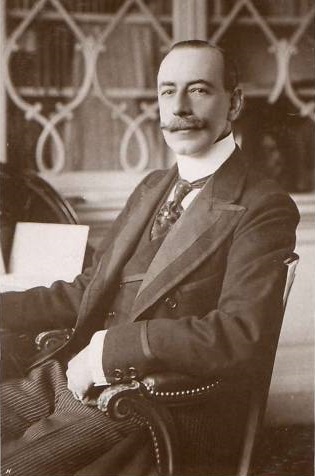
Edward Venables-Vernon-Harcourt was a Church of England bishop. He was the Bishop of Carlisle from 1791 to 1807 and then the Archbishop of York until his death.

Lewis Vernon Harcourt, 1st Viscount Harcourt, was a British Liberal Party politician who held the Cabinet post of Secretary of State for the Colonies from 1910 to 1915. Lord Harcourt's nickname was "Loulou".

Simon Harcourt, 1st Earl Harcourt,, known as Viscount Harcourt between 1727 and 1749, was a British diplomat and general who became Viceroy of Ireland.

Simon Harcourt, 1st Viscount Harcourt, PC of Stanton Harcourt, Oxfordshire, was an English Tory politician who sat in the English and British House of Commons from 1690 until 1710. He was raised to the peerage as Baron Harcourt in 1711 and sat in the House of Lords, becoming Queen Anne's Lord High Chancellor of Great Britain. He was her solicitor-general and her commissioner for arranging the union with Scotland. He took part in the negotiations preceding the Peace of Utrecht.

Baron Vernon, of Kinderton in the County of Chester, is a title in the Peerage of Great Britain. It was created in 1762 for the former Member of Parliament George Venables-Vernon. He had previously represented Lichfield and Derby in the House of Commons. Born George Vernon, he was the son of Henry Vernon, of Sudbury in Derbyshire, and Anne Pigott, daughter and heiress of Thomas Pigott by his wife Mary Venables, sister and heiress of Sir Peter Venables, Baron of Kinderton in Cheshire. In 1728, he assumed by Royal Licence the additional surname of Venables upon inheriting the Venables estate in Cheshire from his childless cousin Anne, widow of the 2nd Earl of Abingdon.

Thomas Parker, 1st Earl of Macclesfield, was an English Whig politician who sat in the House of Commons from 1705 to 1710. He was Lord Chief Justice from 1710 to 1718 and acted briefly as one of the regents before the arrival of King George I in Britain. His career ended when he was convicted of corruption on a massive scale and he spent the later years of his life in retirement at his home, Shirburn Castle in Oxfordshire.

Viscount Harcourt, of Stanton Harcourt in the County of Oxford, was a title created twice for members of the Harcourt family, once in the Peerage of Great Britain and once in the Peerage of the United Kingdom.

The title of Duke of Montagu has been created twice, firstly for the Montagu family of Boughton, Northamptonshire, and secondly for the Brudenell family, Earls of Cardigan. It was first created in the Peerage of England in 1705 for Ralph Montagu, 3rd Baron Montagu of Boughton, with the subsidiary title Marquess of Monthermer, but became extinct in 1749. The 1st Duke had been created Earl of Montagu and Viscount Monthermer in 1689. The Dukedom was then recreated in the Peerage of Great Britain in 1766 for the late Duke's son-in-law George Brudenell, 4th Earl of Cardigan, who adopted the surname of Montagu. On his death in 1790 the dukedom and marquessate became extinct a second time, but the earldom passed to his brother, James Brudenell, 5th Earl of Cardigan.
Edward William Vernon Harcourt DL JP was an English naturalist and Conservative politician.

Nuneham Courtenay is a village and civil parish about 5 miles (8 km) southeast of Oxford. It occupies a pronounced section of the left bank of the River Thames.

George Granville Harcourt was a British Whig and then Conservative Party politician.
Harcourt is a surname, and may refer to:

George Venables-Vernon, 1st Baron Vernon, was a British politician.
Gentleman of the Bedchamber was a title in the royal household of the Kingdom of England from the 11th century, later used also in the Kingdom of Great Britain. A Lord of the Bedchamber was a courtier in the Royal Household; the term being first used in 1718. The duties of the Lords and Gentleman of the Bedchamber originally consisted of assisting the monarch with dressing, waiting on him when he ate, guarding access to his bedchamber and closet and providing companionship. Such functions became less important over time, but provided proximity to the monarch; the holders were thus trusted confidants and often extremely powerful. The offices were in the gift of The Crown and were originally sworn by Royal Warrant directed to the Lord Chamberlain.

The House of Harcourt is a Norman family, and named after its seigneurie of Harcourt in Normandy. Its mottos were "Gesta verbis praeveniant", "Gesta verbis praevenient", and "Le bon temps viendra ... de France".
The Vernon family was a wealthy, prolific and widespread English family with 11th-century origins in Vernon, Normandy, France. Their extant titles include Baron Vernon and Vernon baronets of Shotwick Park.

George Simon Harcourt, 2nd Earl Harcourt, styled Viscount Nuneham until inheriting the title of Earl Harcourt in 1777, was an English politician, patron of the arts, and gardener.
Hon. Simon Harcourt was an English politician who sat in the House of Commons from 1710–15.
William Edward Harcourt, 2nd Viscount Harcourt was an English aristocrat and businessman. Harcourt was a member of the distinguished Harcourt family, who descended from the ancient House of Harcourt in Normandy.














